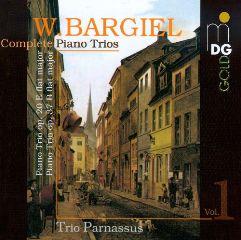Woldemar Bargiel - Piano Trios (Vol.1) [1998]

Trio for violin, cello & piano No.2 in E flat major, Op.20 01. Allegro moderato [0:11:20.07] 02. Andante [0:09:22.00] 03. Scherzo Molto Allegro-Tranquillo [0:05:52.33] 04. Andaante poco Adagio - Allegro [0:07:29.10] Trio for violin, cello & piano No.3 in B flat major, Op.37 05. Allegro moderato, con grazia [0:09:37.70] 06. Andante, molto sostenuto [0:10:13.72] 07. Scherzo, Allegro [0:08:26.25] 08. Allegro moderato [0:08:05.10] Trio Parnassus: Wolfgang Schröder - Violin Michael Groß - Violoncello Chia Chou - Piano
Caught in the musical wars of the 19th Century between the New German School of Wagner and Liszt on one side and the traditionalists of the Leipzig Conservatory led by Brahms and Joachim on the other, Woldemar Bargiel (1828-1897) pleased neither side and was castigated by the critics of his time. History has not yet seen fit to reverse this injustice, but hopefully the emergence of new recordings of his works are a sign of greater recognition to come. These two piano trios are delightful evocations of the Romantic spirit, tuneful in the manner of Schubert and complex enough in construction to repay frequent listening. The Op. 37 trio in particular is really exciting, with the Trio Parnassus in great form. The recording on the audiophile MDG Gold label is impeccable. ---bibliomane01, amazon.com
By the time Bargiel came to write his Piano Trio No.2 in E Flat, Op.20 (1857-8), Schumann was dead, and the music of this trio reflects that Bargiel had, by and large, escaped the great man’s thrall. While this was obviously all to the good from the point of originality, the tight structure and architectural perfection, a Schumann hallmark, are no longer so apparent. When the trio was published in 1860, it did not receive the unstinted praise the First had. The various musical reviews were puzzled by what they called certain harsh harmonizations. Brahms, who maintained a close relationship with Bargiel wrote to Clara, “I saw to a certain extent some progress but I have a genuine fear of everything that has a Lisztian air about it. A lot of things go through my mind when I look at the work. Along with the good...there are instances of harmonic arbitrariness that my ear can’t bear and polyphonic textures in which the counterpoint seems to me to be empty and at times even ugly. It is unlikely that Brahms continued to feel quite the same about the harmonization as time passed. Certainly our ears, from the vantage point of 150 years on, do not take offense at any of the harmonizations we hear, but Brahms’ criticism as to the emptiness of the counterpoint at certain moments remains valid and highlights other problems.
Piano Trio No.3 in B Flat, Op.37 was completed around 1868 and published by Breitkopf and Härtel in 1870. It was well-received and was not attacked for its harmonic harshness as its predecessor had been, probably because by then the music of Liszt, Wagner and the so-called New German School had made considerable headway. Here is another work which Bargiel might well have entitled “Grand” Trio. The opening movement, Allegro moderato, con grazia, starts in rather dainty fashion with the strings and piano almost shyly presenting the attractive and happy main theme. The well-done development unfolds rather leisurely giving a sense spaciousness. The second theme is somewhat more emotional with several dramatic climaxes. The first theme to the following Andante, molto sostenuto, though perhaps not so memorable as one of Schubert’s, is nevertheless of considerable beauty and an immeasurable improvement over the melodic material in the Second Trio. This theme is quiet and valedictory, perhaps based on a folksong. The development is skillful and raises the tension without becoming stormy. The second theme is also quite lyrical. The Andante is the longest of the four movements and primarily autumnal in mood but Bargiel is able to maintain interest throughout. The loud unison opening chords of the Scherzo, Allegro come as a violent shock to the quiet closing of the Andante. They announce something really special, a movement which leaves nothing to be desired from its fiery and heavily accented opening theme, complete with a clever dialog between violin and cello, to its dream-like trio. First rate all the way. The finale, Allegro moderato, begins with a very fetching and lyrical melody given to the cello. The development section is more buoyant and almost becomes a march. The imaginative use of triplets is quite striking. We hear them first as a piano accompaniment figure to the lyrical main theme, then they serve to create a march, and finally they briefly appear as the theme in a fairy dance episode. There is also a second and more heroic theme. In the highly effective coda, the music plunges into almost complete silence before quickly building to a triumphant conclusion. This is really a superb work which should be in the repertoire. It is a great pity that it has been ignored by today’s performing trios. ---chambermusicjournal.org
download (mp3 @320 kbs):








